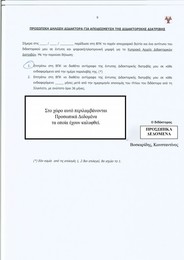Molecular genetic investigation of familial and sporadic focal segmental glomerulosclerosis in Cyprus and Greece

View/
Date
2008-02Author
Voskarides, Konstantinos A.Publisher
Πανεπιστήμιο Κύπρου, Σχολή Θετικών και Εφαρμοσμένων Επιστημών / University of Cyprus, Faculty of Pure and Applied SciencesPlace of publication
CyprusGoogle Scholar check
Keyword(s):
Metadata
Show full item recordAbstract
Μεταλλάξεις στα γονίδια COL4A3/COL4A4 του κολλαγόνου IV, συστατικού των σπειραματικών βασικών μεμβρανών, έχουν βρεθεί περίπου στο 40% των περιπτώσεων της νεφροπάθειας των λεπτών βασικών μεμβρανών που χαρακτηρίζεται στη βιβλιογραφία με εξαίρετη πρόγνωση, οδηγώντας σπάνια σε σοβαρή πρωτεινουρία και χρόνια νεφρική ανεπάρκεια (ΧΝΑ). Λίγες είναι οι αναφορές που συνδέουν τη ΝΛΒΜ με άλλες σπειραματοπάθειες, όπως η εστιακή τμηματική σπειραματική σκλήρυνση (ΕΤΣΣ). Σε αυτή τη μελέτη ερευνήσαμε 13 οικογένειες από τις οποίες λήφθηκαν 373 δείγματα, εκ των οποίων 116 ανήκουν σε άτομα που εμφανίζουν κλινικά συμπτώματα της ΕΤΣΣ. Πραγματοποιήσαμε γενετική ανάλυση σύνδεσης σε τρεις γενετικές περιοχές που αφορούν πρωτοπαθή ΕΤΣΣ και σε μία που αφορά τη λεγόμενη «καλοήθη αιματουρία» η οποία είχε δειχθεί σε μικρό αριθμό περιστατικών να συνοδεύεται από ΕΤΣΣ. Με έκπληξή μας παρατηρήσαμε ότι στις περισσότερες οικογένειες υπήρχε σύνδεση με την τελευταία γενετική περιοχή η οποία περιλαμβάνει τα κολλαγονικά γονίδια COL4A3 και COL4A4. Σε ανίχνευση μεταλλάξεων στα γονίδια αυτά, βρήκαμε τρεις μεταλλάξεις σε ετεροζυγία, γεγονός που συνάδει με τη διάγνωση της Νεφροπάθειας των Λεπτών Βασικών Μεμβρανών.
Η πιο συχνή μετάλλαξη, η G1334E, με ανάλυση ανισοζυγίου σύνδεσης υπολογίστηκε η εμφάνισή της 5-1Θ γενιές πίσω (περίπου πριν 300 χρόνια). Όσον αφορά την εξέλιξη της νόσου, δείξαμε ότι σε σύνολο 82 ασθενών που είναι ετερόζυγοι για μία μετάλλαξη στο COL4A3 ή στο COL4A4, για τους οποίους είχαμε λεπτομερή κλινικά στοιχεία, ποσοστό 38% ανέπτυξαν νεφρική ανεπάρκεια ποικίλου βαθμού ενώ ποσοστό 19.5% προχώρησαν σε νεφροπάθεια τελικού σταδίου και ανάγκη για αιμοκάθαρση ή μεταμόσχευση νεφρού. Αυτά τα στοιχεία απέχουν πολύ από τα δεδομένα της βιβλιογραφίας, όπου για ασθενείς φορείς παρόμοιων μεταλλάξεων αναφέρεται μια μακροχρόνια καλοήθης πορεία
. Η διερεύνηση περιπτώσεων ΕΤΣΣ παιδικής ηλικίας ήταν ένα άλλο σημαντικό μέρος της μελέτης αυτής. Μελετήθηκαν 24 σποραδικές περιπτώσεις παιδιών, από Ελλάδα και Κύπρο, με στεροειδοανθεκτικό νεφρωτικό σύνδρομο (ΣΝΣ) και τα περισσότερα με βιοψία ΕΤΣΣ. Επιχειρήθηκε ανίχνευση μεταλλάξεων στο WT1 (εξόνια 8 και 9), και στο NPHS2. Στο WT1 δε βρέθηκαν καθόλου ενώ στο NPHS2 βρέθηκαν δύο γνωστές μεταλλάξεις (418delG, R229Q) και μία άγνωστη (L305P), ποσοστό 8.3% από τα 24 παιδιά. Παρόλο που στην παρούσα μελέτη ο αριθμός των ασθενών ήταν σχετικά μικρός, τα αποτελέσματα δικαιολογούν τη χρησιμότητα της μοριακής διάγνωσης μεταλλάξεων στο NPHS2, αφού συνεισφέρει σημαντικά στην επιλογή κατάλληλης θεραπείας στα παιδιά με νεφρωτικό σύνδρομο. Mutations in the COL4A3/COL4A4 genes of the type IV collagen component of glomerular basement membranes (GBM) have been found in ~ 40% of cases of Thin Basement Membrane Nephropathy (TBMN) which is considered of excellent prognosis, rarely leading to proteinuria and chronic renal failure (CRF). Occasionally it has been associated with other glomerulopathies such as focal segmental glomerulosclerosis (FSGS). Here we report on 13 Cypriot families with 373 subjects, 116 of whom were clinically diagnosed to be affected. All families came to our attention because of the diagnosis of FSGS in 20 renal biopsies. Based on the above observations we formulated a hypothesis according to which these families segregated a familial form of primary FSGS, a progressive disease that eventually leads to chronic renal failure and frequently also to end- stage renal disease, something that happened in many of our patients. However, we did not exclude the probability that the FSGS phenotype was of a secondary aetiology. To this end, we performed genetic linkage analysis at three genetic loci (genes: ACTN-4, CD2AP, TRPC6) associated with primary FSGS and at one locus which was reported to be occasionally associated with secondary FSGS (genes: COL4A3, COL4A4, locus 2q36). We found positive linkage at locus 2q36 and subsequent DNA sequencing identified founder mutations in both, the COL4A3 and COL4A4 genes in 10 families. None of 82 heterozygous patients, of whom we had detailed clinical infirmation, had any other extrarenal manifestations, thereby justifying the diagnosis of TBMN, in accordance also, with electron microscopy results that showed uniform thinning of the GBM. On follow up (up to three decades), 31 of these 82 patients (37.8%) developed CRF while 16 (19.5%) reached end stage renal disease (ESRD). Mutation G1334E was introduced by a founder approximately 300 years ago and was detected in seven families with apparent distant unknown relationship, on common haplotype K.
Early onset FSGS was the other main part of our project, studying NPHS2 and WT1 genes. Mutations in the NPHS2 gene, encoding podocin, are an important cause of infantile sporadic Steroid Resistant Nephrotic Syndrome (SRNS) and familial cases of early onset FSGS. To a lesser extend mutations in the WT1 gene are also found in patients with SRNS. We performed mutational analysis of the NPHS2 and WT1 (exons 8 and 9) genes in 24 children with SRNS, most of them with biopsy-proven FSGS. No mutation or polymorphism was identified in exons 8 and 9 of WT1. We identified two known mutations (418delG, R229Q) and one novel mutation (L305P) in the NPHS2 gene, in two out of the 24 children (8.3%), in addition to nine known polymorphisms. Although the studied cohort was small, our investigation supports the usefulness of the availability in routine clinical set up, as it assists in appropriate treatment of affected children.
